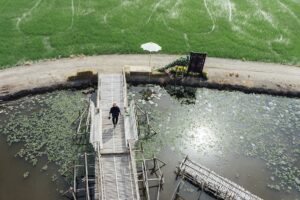Access to clean and safe water is one of the most critical challenges of the 21st century. Water treatment and desalination technologies play a vital role in providing potable water for communities, industries, and agriculture. With increasing water scarcity and growing populations, sustainable water solutions are essential.
At Anin Engineering Company, we specialize in industrial, mining, recreational, and healthcare projects, including advanced water treatment and desalination systems. Our approach ensures high efficiency, environmental compliance, and long-term sustainability.
1. Importance of Water Treatment and Desalination
Clean water is crucial for health, economic development, and environmental protection. Water treatment ensures that contaminants, pathogens, and pollutants are removed, while desalination converts seawater or brackish water into potable water.
Key benefits include:
-
Providing safe drinking water for communities
-
Supporting industrial and agricultural operations
-
Protecting ecosystems by reducing pollution
-
Enhancing resilience in regions facing water scarcity
Water treatment and desalination are increasingly part of integrated solutions to meet both urban and industrial water demands.
2. Types of Water Treatment Technologies
Water treatment processes vary depending on the source and level of contamination. Common methods include:
Filtration Systems
Removes suspended particles, sediment, and turbidity. Includes sand filters, multimedia filters, and membrane filtration.
Chemical Treatment
Uses chemicals like chlorine or ozone to disinfect water and remove harmful microorganisms.
Reverse Osmosis (RO)
A common method in desalination that removes salts, minerals, and contaminants using a semi-permeable membrane.
UV and Advanced Oxidation
Disinfection methods that reduce microbial contamination without adding chemicals, preserving water quality.
3. Desalination Methods
Desalination converts saline water into freshwater and is particularly valuable in arid regions or coastal cities. The primary techniques include:
-
Reverse Osmosis (RO): Uses high-pressure membranes to remove salts. Efficient and widely used.
-
Multi-Stage Flash (MSF): Evaporates water in multiple stages and condenses it as freshwater.
-
Multi-Effect Distillation (MED): Uses heat to evaporate water in several stages, optimizing energy use.
Each method has advantages and limitations depending on the scale, water quality, and energy availability.
4. Industrial Applications
Water treatment and desalination are essential in various industries:
-
Mining Projects: Provide process water for extraction and reduce environmental impact.
-
Industrial Plants: Ensure water meets quality standards for manufacturing processes.
-
Healthcare Facilities: Deliver clean water for hospitals and laboratories.
-
Recreational Complexes: Maintain water quality in pools, spas, and fountains.
Properly designed water systems reduce operational risks and promote environmental sustainability.
5. Design and Implementation
Designing water treatment and desalination projects involves several stages:
Feasibility Studies
Evaluate water sources, treatment needs, and economic viability. This ensures that the project meets both financial and environmental goals.
Process Design
Select appropriate technologies, define flow rates, and determine energy requirements. Membrane selection, chemical dosing, and filtration strategies are critical.
Construction and Installation
Build treatment plants, install pumps, tanks, pipelines, and membranes. Compliance with safety and environmental regulations is mandatory.
Commissioning and Testing
Ensure the system performs as designed, meets water quality standards, and operates efficiently.
6. Role of Technology
Modern water treatment relies on technology to improve efficiency and reduce costs:
-
Smart Monitoring Systems: Track water quality in real-time and optimize chemical dosing.
-
Automated Controls: Reduce manual intervention and maintain stable operation.
-
Energy Recovery Devices: Particularly in RO systems, these reduce electricity consumption.
-
Advanced Sensors: Detect contaminants, turbidity, and microbial activity quickly.
Technological innovation is key to sustainable water management and cost-effective operation.
7. Environmental Considerations
Water treatment and desalination projects must prioritize environmental sustainability:
-
Minimize chemical discharge and brine disposal
-
Reduce energy consumption through efficient systems
-
Reuse and recycle treated water where possible
-
Conduct environmental impact assessments before construction
By addressing environmental concerns, projects achieve regulatory compliance and long-term community acceptance.
8. Challenges in Water Treatment and Desalination
Despite advances, challenges remain:
-
High Energy Costs: Especially for desalination methods like RO and MED
-
Brine Disposal: Saline byproducts can harm marine ecosystems if not managed properly
-
Operational Complexity: Requires skilled personnel and continuous monitoring
-
Capital Investment: Initial costs can be significant, though offset by long-term benefits
9. Economic Feasibility
A successful water project requires a thorough economic analysis:
-
Evaluate capital expenditure and operational costs
-
Forecast water demand and revenue streams
-
Assess risks and uncertainties
-
Ensure return on investment (ROI) is acceptable
Feasibility studies help in selecting the most cost-effective and sustainable water treatment solution.
10. Case Study: Water Treatment Project
At Anin Engineering Company, we designed and implemented a state-of-the-art desalination and water treatment facility for a large industrial complex. Highlights include:
-
Reverse osmosis desalination with energy recovery
-
Advanced filtration and chemical treatment for potable water
-
Continuous monitoring and automated control systems
-
Environmentally responsible brine management
This project demonstrates the importance of combining technology, expertise, and sustainable practices.
Conclusion
Water treatment and desalination are critical components for industrial, mining, healthcare, and recreational projects. They ensure a reliable supply of clean water while minimizing environmental impact.
If you are planning a water project and want professional guidance for design, implementation, and sustainability, contact Anin Engineering Company today. Our team has the expertise to deliver efficient, environmentally responsible water solutions tailored to your needs.
FAQ
1. What is water treatment and desalination?
Water treatment removes contaminants from water to make it safe for consumption or industrial use, while desalination converts seawater or brackish water into potable water.
2. What are the main methods of water treatment?
Common methods include filtration, chemical treatment, reverse osmosis (RO), UV disinfection, and advanced oxidation processes.
3. How does desalination work?
Desalination typically uses reverse osmosis or thermal processes like multi-stage flash (MSF) and multi-effect distillation (MED) to remove salts from water.
4. Why is water treatment important for industries?
It ensures water meets quality standards, protects equipment, maintains production efficiency, and reduces environmental impact.
5. Can desalination help in water-scarce regions?
Yes, desalination provides a reliable freshwater source in arid or coastal regions where natural freshwater is limited.
6. What are the environmental concerns with desalination?
Challenges include energy consumption and brine disposal, which can impact marine ecosystems if not properly managed.
7. How can technology improve water treatment?
Automation, real-time monitoring, energy recovery systems, and advanced sensors enhance efficiency, reduce costs, and ensure consistent water quality.
8. What is the cost of implementing a water treatment or desalination project?
Costs depend on scale, technology, and location. While initial investment may be high, long-term benefits and sustainability make it cost-effective.
9. How does Anin Engineering Company support water projects?
We provide full-service design, implementation, and monitoring of water treatment and desalination systems for industrial, mining, healthcare, and recreational projects.
10. Where can I see examples of water treatment projects by Anin?
You can check our Water Treatment Projects page to see detailed case studies and solutions.





